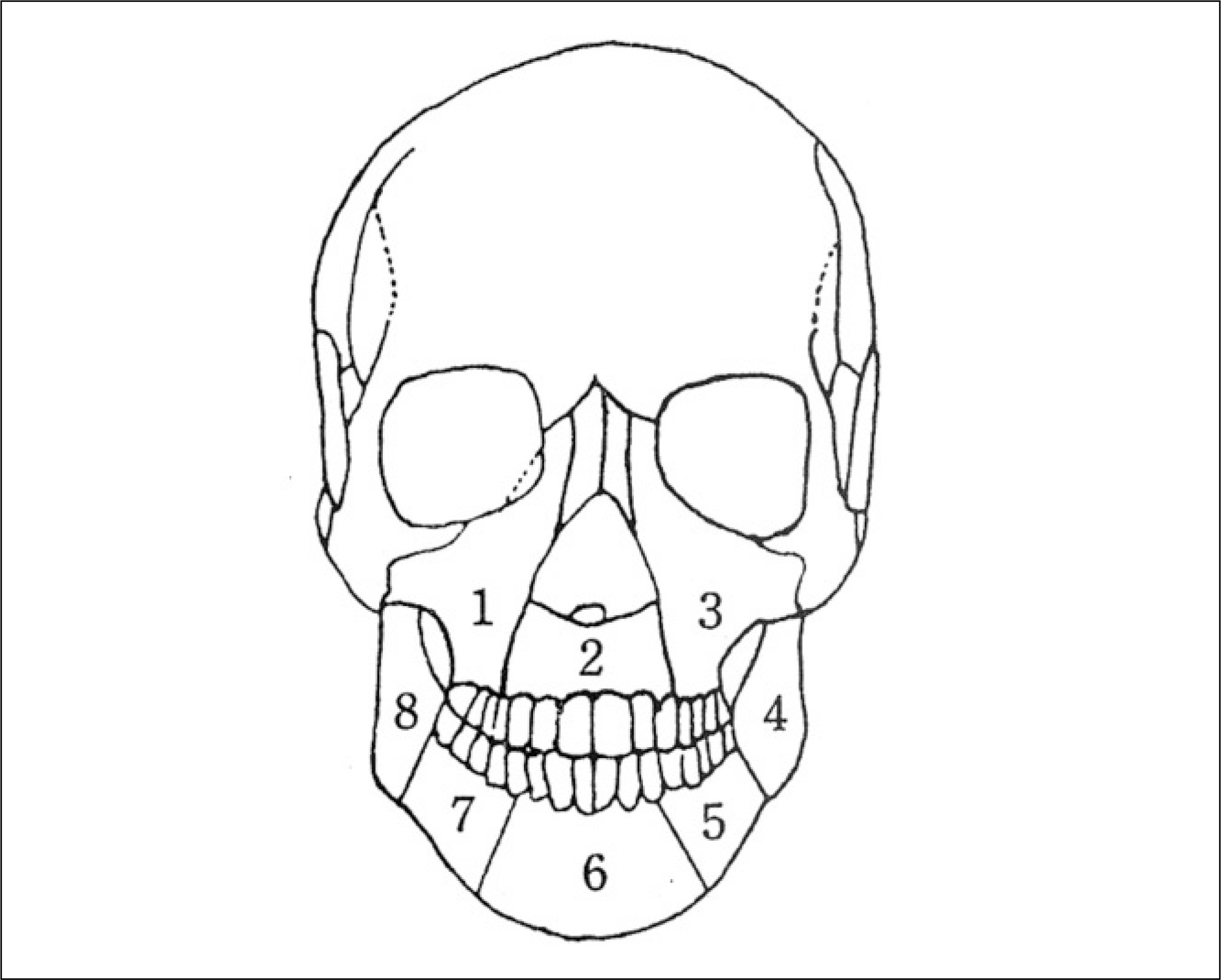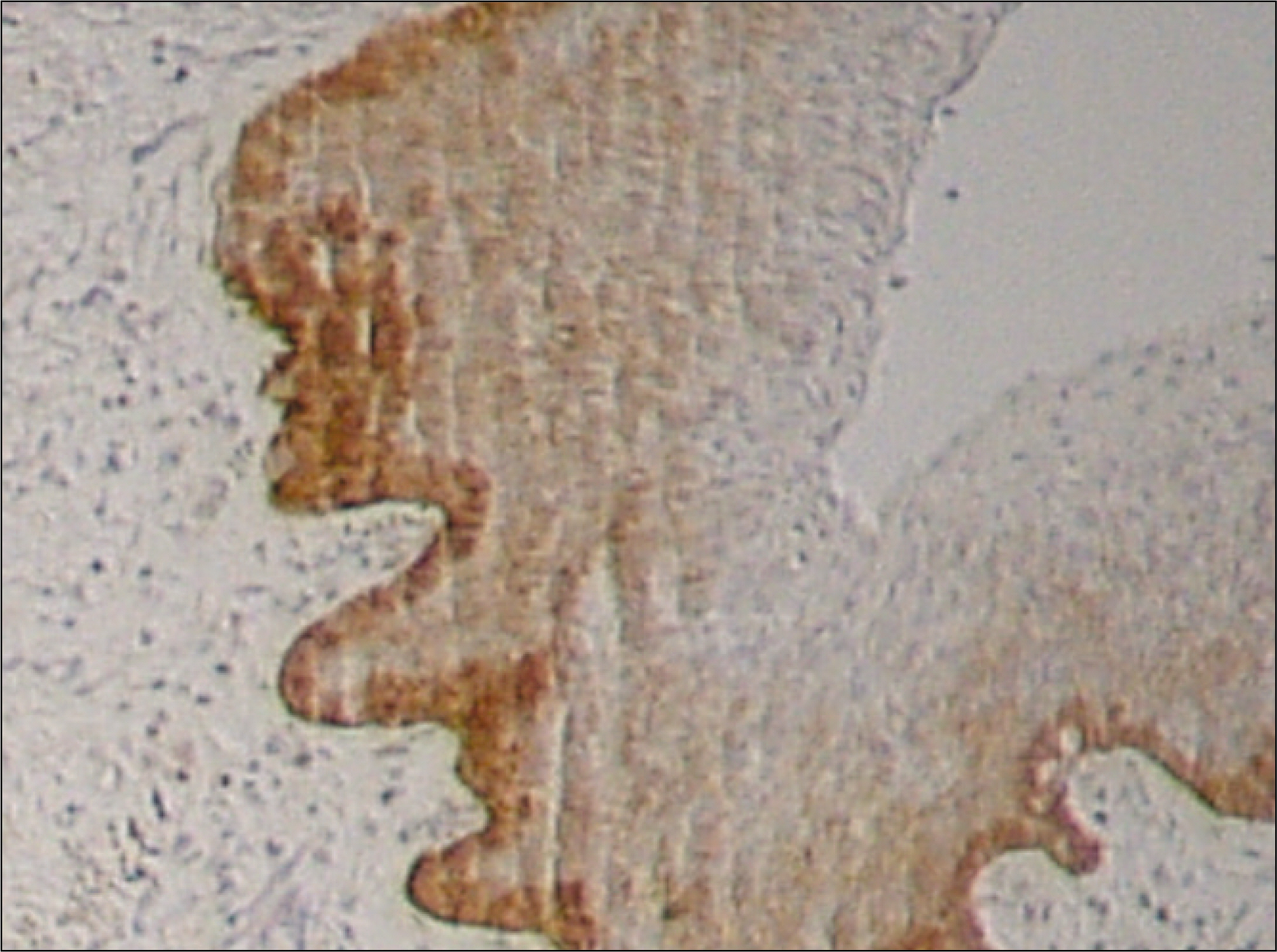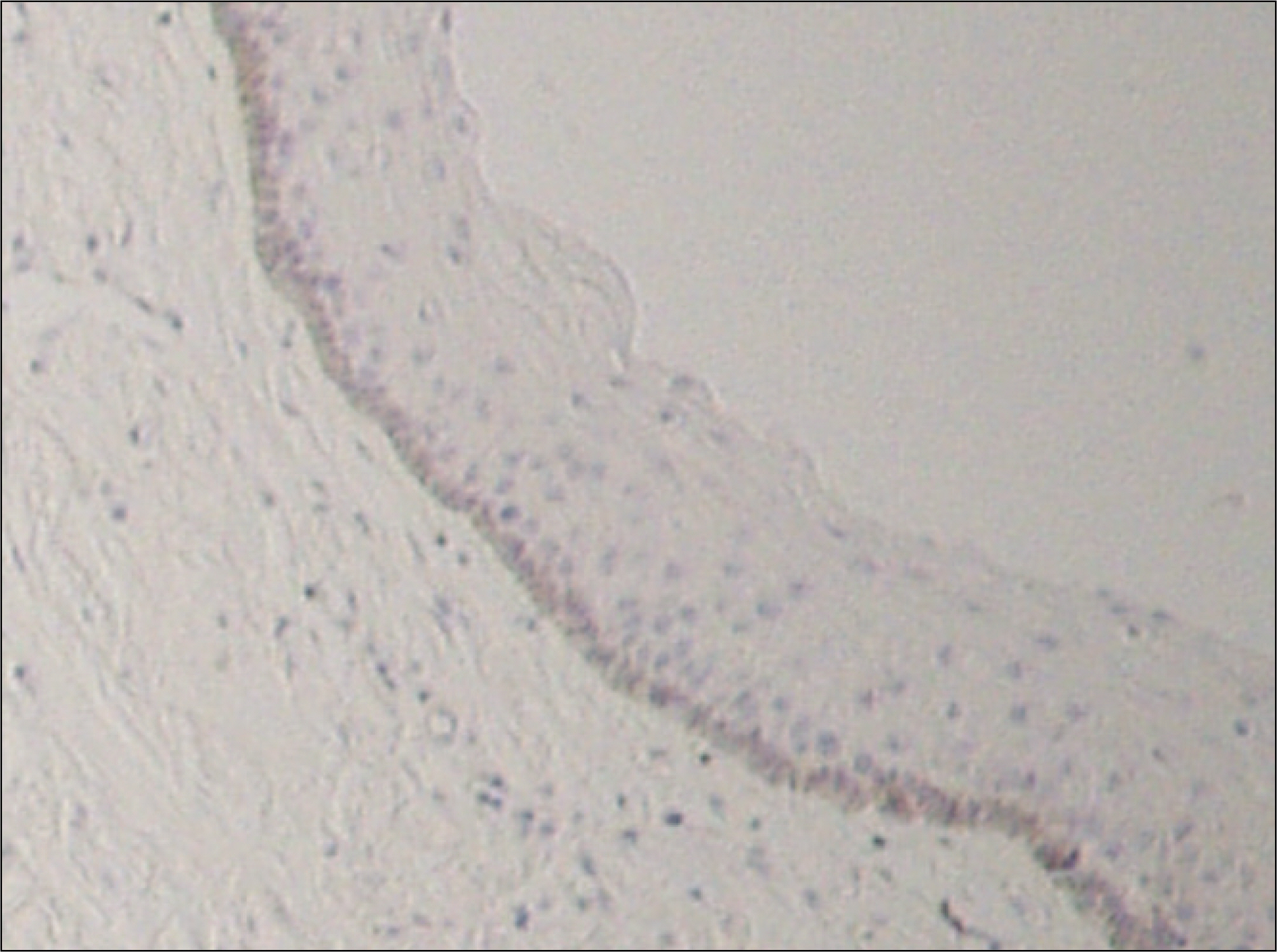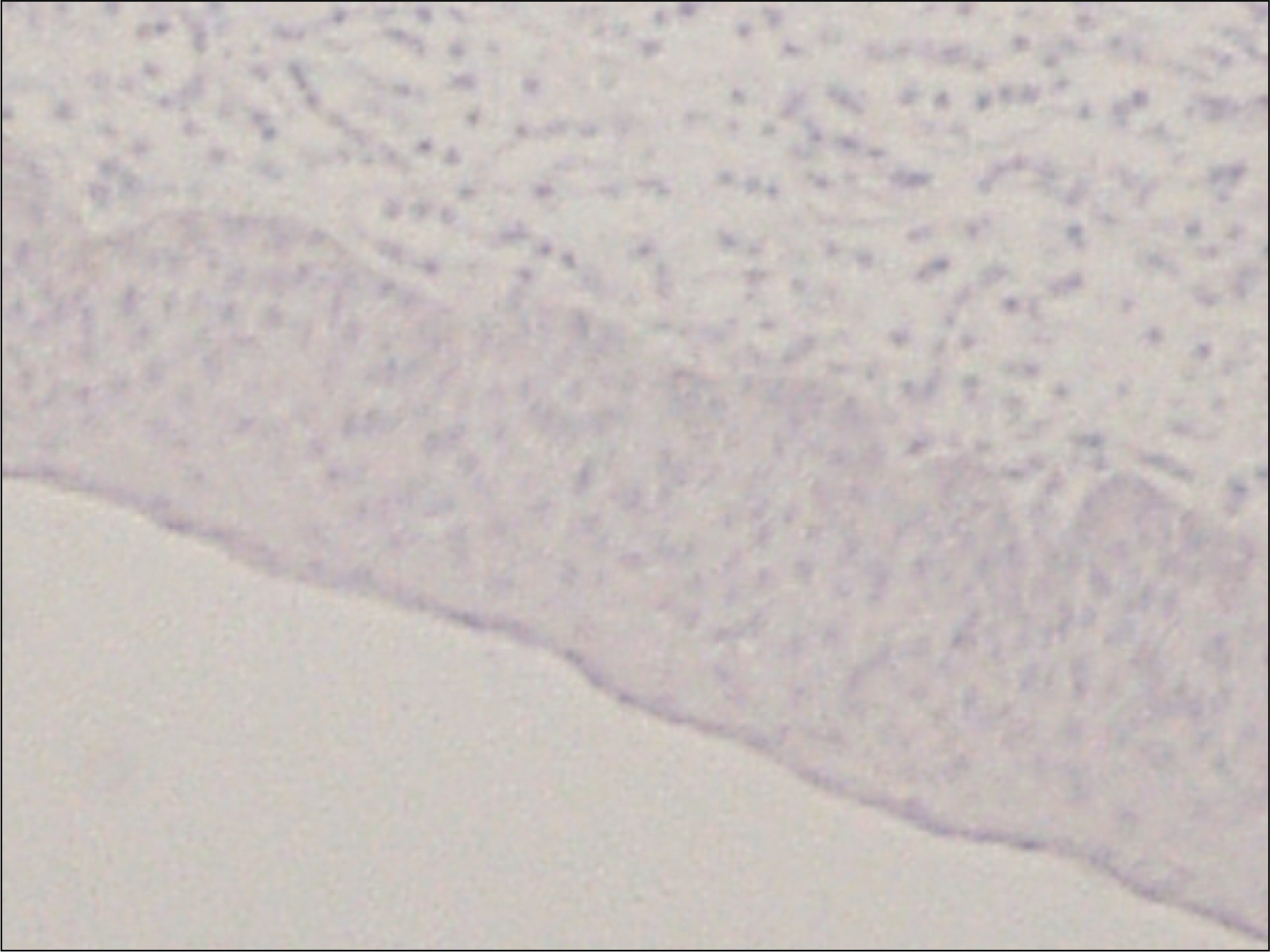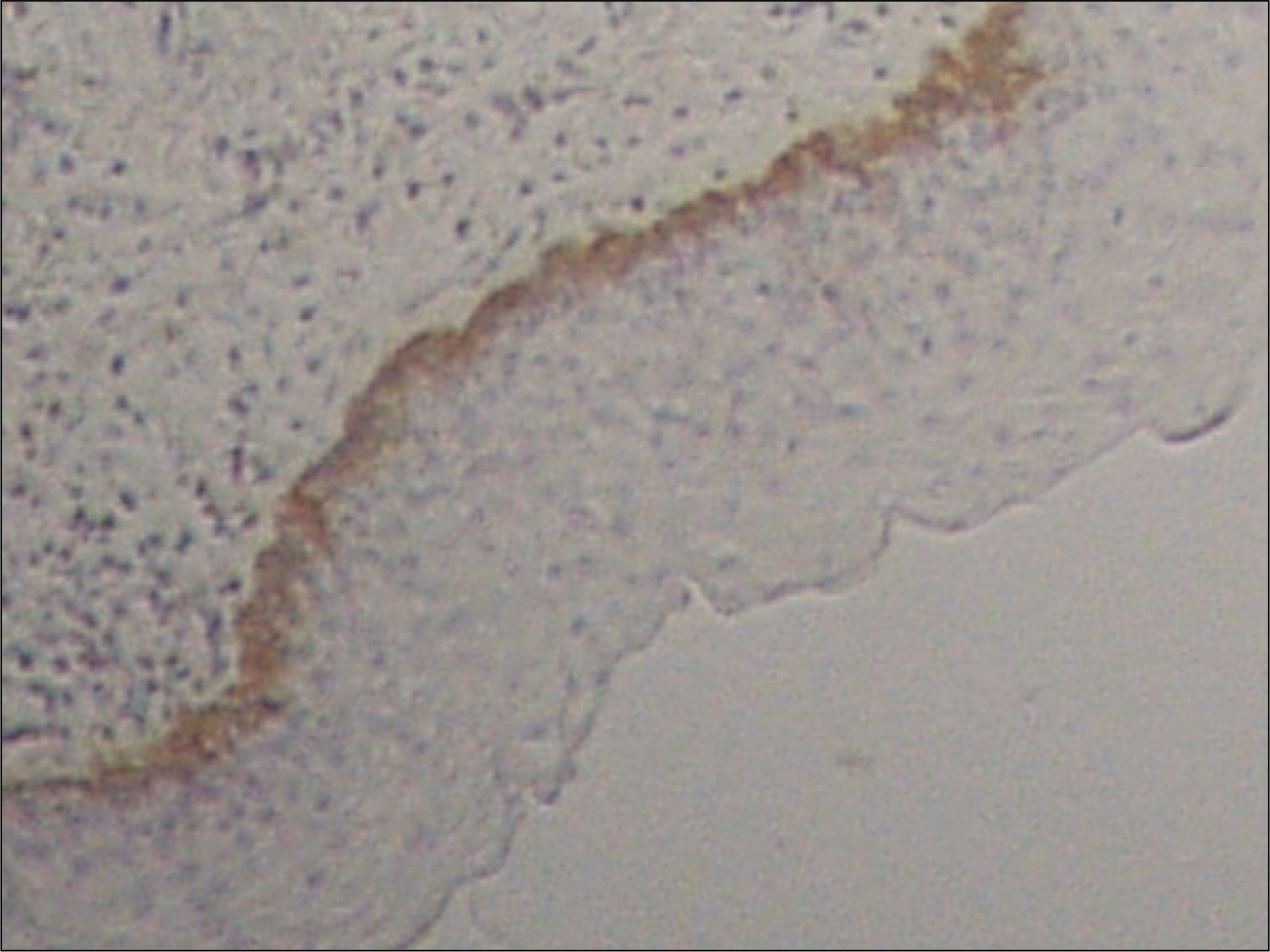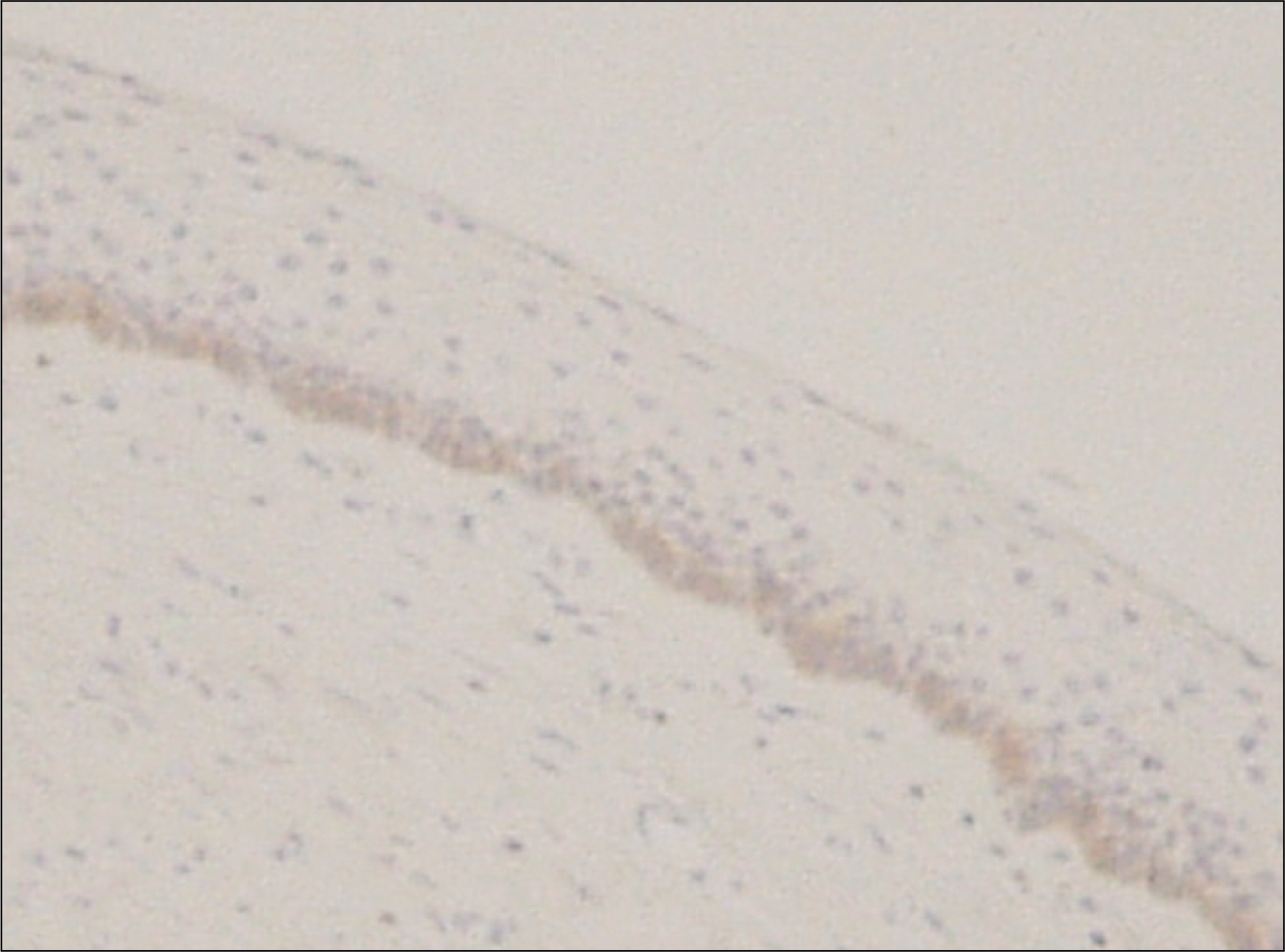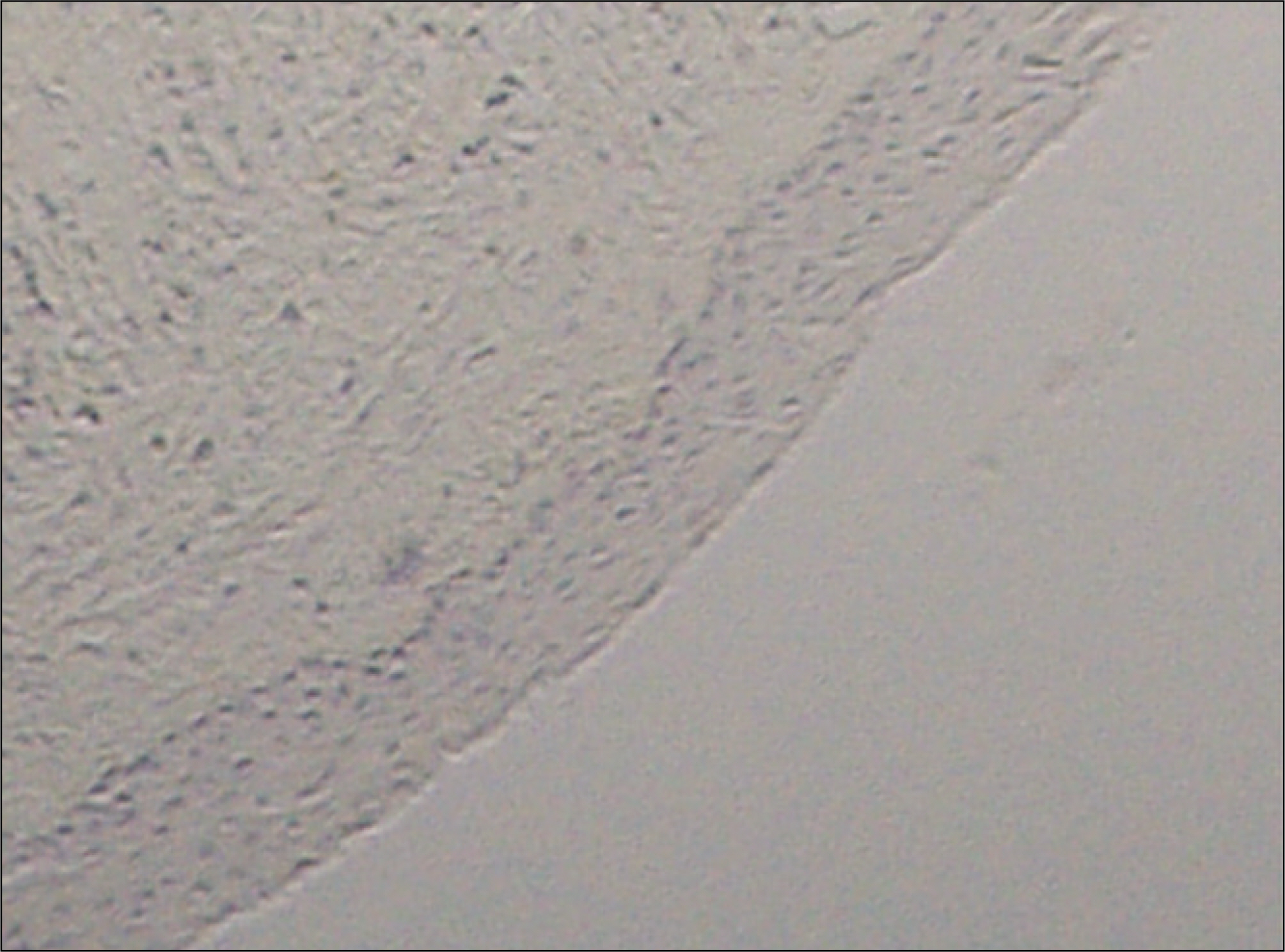J Korean Assoc Oral Maxillofac Surg.
2011 Jun;37(3):161-168. 10.5125/jkaoms.2011.37.3.161.
Expression of Bcl-2 in the epithelial lining and clinical findings of keratocystic odotogenic tumor
- Affiliations
-
- 1Department of Oral and Maxillofacial Surgery, School of Dentistry, Kyungpook National University, Daegu, Korea. kimcs@knu.ac.kr
- KMID: 2189765
- DOI: http://doi.org/10.5125/jkaoms.2011.37.3.161
Abstract
- PURPOSE
The odontogenic keratocysts demonstrated a high recurrence rate and a biologically aggressive nature. This might be due to unknown factors inherent in the epithelium or enzymatic activity in the fibrous wall. Bcl-2 protein is characterized by its ability to inhibit apoptosis. The aim of this study was to evaluate the expression and distribution of bcl-2 in the OKCs, its possible relationship with the tumorous characteristics, such as the aggressive nature and high recurrence rate, and its usefulness to differentiate OKCs from dentigerous cysts.
MATERIALS AND METHODS
Formalin fixed paraffin-embedded tissue sections of 53 OKCs, and 44 dentigerous cyst were immunohistochemically analyzed quantitatively for the immunoreactivity of the bcl-2 protein with i-solution.
RESULTS
More Bcl-2 expression was observed in the OKCs (mean34.387%) than dentigerous cyst (mean11.144%) with statistical significance (P<0.001). Seventeen and 15 of the 32 OKCs in this study showed positivity in the basal layer and basal/suprabasal layers, respectively. In dentigerous cyst, 2 of 3 showed positivity in the basal cell layer.
CONCLUSION
Considering that bcl-2 over expression may lead to the increased survival of epithelial cells, this study demonstrated a possible relationship between the aggressive nature of OKC and the intrinsic growth potential of its lining epithelium. Furthermore, the basal/suprabasal distribution of bcl-2 positive cells was observed in some OKCs, which might have a significant impact on the behavior of cysts. The bcl-2 expression of OKCs can be useful for differentiating OKCs from dentigerous cysts.
MeSH Terms
Figure
Reference
-
References
1. Philipsen HP. Om Keratocyster(Kolesteatomer) I Kaeberne. Tandlaegebladet. 1956; 60:963–80.2. Pindborg JJ, Hansen J. Studies on odontogenic cyst epithelium: 2.Clinical and roentgenologic aspects of odontogenic keratocysts. Acta Pathol Microbiol Scand. 1963; 58:283–94.3. Giuliani M, Grossi GB, Lajolo C, Bisceglia M, Herb KE. Conservative management of a large odontogenic keratocyst: report of a case and review of the literature. J Oral Maxillofac Surg. 2006; 64:308–16.
Article4. Barnes L. Surgical pathology of the head and neck. 1st ed.New York: Marcel Dekker;1985.5. el-Hajj G, Anneroth G. Odontogenic keratocysts-a retrospective clinical and histologic study. Int J Oral Maxillofac Surg. 1996; 25:124–9.
Article6. Chow HT. Odontogenic keratocyst: a clinical experience in Singapore. Oral Surg Oral Med Oral Pathol Oral Radiol Endod. 1998; 86:573–7.7. Chun SD, An CH, Choi KS. Radiographic study of the odontogenic keretocyst. Korean J Oral Maxillofac Radiol. 2005; 35:51–4.8. Shear M. The aggressive nature of the odontogenic keratocyst: Is it a benign cystic neoplasm? Part 2. Proliferation and genetic studies. Oral Oncol. 2002; 38:323–31.9. Madras J, Lapointe H. Keratocystic Odontogenic Tumour: reclassification of the odontogenic keratocyst from cyst to tumour. J Can Dent Assoc. 2008; 74:165–165h.10. Stoll C, Stollenwerk C, Riediger D, Mittermayer C, Alfer J. Cytokeratin expression patterns for distinction of odontogenic keratocysts from dentigerous and radicular cysts. J Oral pathol Med. 2005; 34:558–64.
Article11. Meara JG, Pilch BZ, Shah SS, Cunningham MJ. Cytokeratin expression in the odontogenic keratocyst. J Oral Maxillofac Surg. 2000; 58:862–5.
Article12. August M, Faquin WC, Troulis M, Kaban LB. Differentiation of odontogenic keratocysts from nonkeratinizing cyst by use of fine-needle aspiration biopsy and cytokeratin-10 staining. J Oral Maxilloc Surg. 2000; 58:935–40.13. Song MY, Lee SS, Lee JK, Yi WJ, Heo MS, Lee JI, et al. Relation of the radiologic findings and labeling index of Ki-67, PCNA and cytokeratin in unicystic ameloblastoma, dentigerous cyst and odontogenic keratocyst. Korean J Oral Maxillofac Radiol. 2004; 34:75–9.14. Lee SG, Lee JH, Kim CH. Immunohistochemical Study of Odontogenic Keratocyst. J Korean Assoc Maxillofac Plast Reconstr Surg. 2004; 26:469–76.15. Slootweg PJ. P53 protein and Ki-67 reactivity in epithelial odontogenic lesions. An immunohistochemical study. J Oral Pathol Med 1995 Oct;24 (9):. 393–7.16. Hockenbery DM, Zutter M. Hickey W, Nahm M, Korsmeyer SJ. BCL2 protein is topographically restricted in tissues characterized by apoptotic cell death. Proc Natl Acad Sci USA. 1991; 88(16):6961–5.17. Gee JM, Robertson JF, Ellis IO, Willsher P, McClelland RA, Hoyle HB, et al. Immunocytochemical localization of BCL-2 protein in human breast cancers and its relationship to a series of prognostic markers and response to endocrine therapy. Int J Cancer. 1994; 59:619–28.
Article18. Colombel M, Symmans F, Gil S, O'Toole KM, Chopin D, Benson M, et al. Detection of the apoptosis-suppressing oncoprotein bcl-2 in hormone-refractory human prostate cancers. Am J Pathol 1993 Aug;143:. 390–400.19. Pezzella F, Turley H, Kuzu I, Tungekar MF, Dunnill MS, Pierce CB, Harris A, Gatter KC, Mason DY. BCL-2 protein in nonsmall-cell lung carcinoma. N Engle J Med. 1993; 329:690–4.
Article20. Skopelitou A, Hadjiyannakis M, Alexopoulou V, Krikoni O, Kamina S, Agnantis N. Topographical immunohistochemical expression of bcl-2 protein in human liver lesions. Anticancer Res. 1996; 16:975–8.21. Lauwers GY, Scott GV, Hendricks J. Immunohistochemical evidence of aberrant bcl-2 protein expression in gastric epithelial dysplasia. Cancer. 1994; 73:2900–4.22. Virkaja ¨rvi N, Pa ¨a ¨kko ¨ P, Soini Y. Apoptotic index and apoptosis influencing proteins bcl-2, mcl-1, bax and caspases 3, 6 and 8 in pancreatic carcinoma. Histopathology. 1998; 33:432–9.
Article23. Eid H, Gulya ′ s M, Ge ′ czi L, Bodrogi I, Institoris E, Bak M. Expression of bcl-2 in testicular carcinoma: correlation with tumor progression and MDR1/Pgp. Cancer. 1998; 83:331–6.24. Lu QL, Abel P, Foster CS, Lalani EN. Bcl-2: role in epithelial differentiation and oncogenesis. Hum Pathol. 1996; 27:102–10.
Article25. Piattelli A, Fioroni M, Rubini C. Differentiation of odontogenic keratocysts from other odontogenic cysts by the expression of bcl-2 immunoreactivity. Oral Oncol. 1998; 34:404–7.
Article26. Toller P. Origin and growth of cysts of the jaws. Ann R Coll Surg Engl. 1967; 40:306–36.27. Gonza ′ lez-Alva P, Tanaka A, Oku Y, Yoshizawa D, Itoh S, Sakashita H, et al. Keratocystic odontogenic tumor: a retrospective study of 183 cases. J Oral Sci. 2008; 50:205–12.
Article28. Ogden GR, Chisholm DM, Kiddie RA, Lane DP. P53 protein in odontogenic cysts: increased expression in some odontogenic keratocysts. J Clin Pathol. 1992. 45. : 1007–10.
Article29. Ahlfors E, Larsson A, Sjo ¨gren S. The odontogenic keratocyst: a benign cystic tumor? J Oral Maxillofac Surg. 1984; 42:10–9.
Article30. Brannon RB. The odontogenic keratocyst; a clinicopathologic study of 312 cases. Part Ⅰ. Clinical features. Oral Surg Oral Med Oral Pathol. 1976; 42:54–72.31. Browne RM. The odontogenic keratocyst: clinical aspects. Br Dent J. 1970; 128:225–31.
Article32. Browne RM. The odontogenic keratocyst: histological features and their correlation with clinical behaviour. Br Dent J. 1971; 131:249–59.
Article33. Magnusson BC. Odontogenic keratocysts: a clicical and histological study with special reference to enzyme histochemistry. J Oral Pathol. 1978; 7:8–18.34. Forssell K, Sorvari TE, Oksala E. A clinical and radiographic study of odontogenic keratocysts in jaws. Proc Finn Dent Soc. 1974; 70:121–34.
Article35. Shear M. Developmental odontogenic cysts: an update. J Oral Pathol Med. 1994; 23:1–11.36. Arafat A, Lunin M. Odontogenic keratocysts. J Baltimore Coll Dental Surg. 1984; 36:5–13.37. Philipsen HP. Keratocystic odontogenic tumour. Barnes L, Eveson JW, Reichart P, Sidransky D, editors. World Health Organization classification of tumours: pathology and genetics of head and neck tumours. Lyon: IARC Press;2005. p. 306–7.38. Marker P, Br � ndum N, Clausen PP, Bastian HL. Treatment of large odontogenic keratocysts by decompression and later cystectomy: a longterm follow-up and a histologic study of 23cases. Oral Surg Oral Med Oral Pathol Oral Radiol Endod. 1996; 82:122–131.39. Donoff RB, Guralnick WC, Clayman L. Keratocysts of the jaws. J Oral Surg. 1972; 30:800–4.40. Omura S, Kawabe R, Kobayashi S, Mizuki N. Odontogenic keratocyst appearing as a soap-bubble or honeycomb radiolucency: report of a case. J Oral Maxillofac Surg. 1997; 55:185–9.
Article41. Kumar V, Abbas AK, Fausto N. Robbinson and Cotran pathologic basis of disease. 7th ed.Philadelpia: Elsevier Saunders;2005. p. 26–32.42. Perumalsamy LR, Nagala M, Sarin A. Notch-activated signaling cascade interacts with mitochondrial remodeling proteins to regulate cell survival. Proc Natl Acad Sci USA. 2010; 107:6882–7.
Article43. Kernohan NM, Cox LS. Regulation of apoptosis by bcl-2 and its related proteins: immunochemical challenges and therapeutic implications. J Pathol. 1996; 179:1–3.44. Nicholson DW, Thornberry NA. Caspases: killer proteases. Trends Biochem Sci. 1997; 22:299–306.
Article45. Villa P, Kaufmann SH, Earnshaw WC. Caspases and caspase inhibitors. Trends Biochem Sci. 1997; 22:388–93.
Article46. Singh BB, Chandler FW Jr, Whitaker SB, Forbes-Nelson AE. Immunohistochemical evaluation of bcl-2 oncoprotein in oral dysplasia and carcinoma. Oral Surg Oral Med Oral Pathol Oral Oadiol Endod. 1998; 85:692–8.
Article47. Lo Muzio L, Staibano S, Pannone G, Bucci P, Nocini PF, Bucci E, De Rosa G. Expression of cell cycle and apoptosis-related proteins in sporadic odontogenic keratocysts and odontogenic keratocysts associated with the nevoid basal cell carcinoma syndrome. J Dent Res. 1999; 78:1345–53.
Article48. Jahanshahi GH, Talebi A, Shirvani A. Expression of bcl-2 in the epithelial lining of odontogenic keratocysts. J Dent Tehran Univ Medical Sci. 2006; 3:: no. (1):49. Singh B, Chandler F, Gaugham Jr G, Whitaker b, Zunt S. Immunohistochemical status of bcl-2 oncoprotein in the odontogenic keratocyst. In: Abstract and clinical pathologic conference cases presented at the 52nd Academy of Oral and Maxillofacial Pathology. Oral Surg Oral Med Oral Pathol. 1998; 86:207–19.50. Birchall MA, Winterford CM, Allan DJ, Harmon BV. Apoptosis in normal epithelium, premalignant and malignant lesions of the oropharynx and oral cavity: a preliminary study. Eur J Cancer B Oral Oncol. 1995; 31B(6):380–3.
Article51. Rodriguez-Villanueva J, Colome MI, Brisbay S, McDonnell TJ. The expression and localization of bcl-2 protein in normal skin and in nonmelanoma skin cancers. Pathol Res Pract. 1995; 191:391–8.
Article
- Full Text Links
- Actions
-
Cited
- CITED
-
- Close
- Share
- Similar articles
-
- Expression of bcl-2 , p53 Protein and Aggressiveness in Thymic Epithelial Tumor
- Carnoy's Solution Application for Patient Preliminarily Diagnosed with Keratocystic Odotogenic Tumor: Case Report
- Histopathologic Re-evaluation of Thymoma with Immunonhistochemical Study for bcl-2 and MIC-2 Protein
- Prognostic Significance of Bcl-2 Expression in Ovarian Cancers
- A Study of Immunohistochemical Evaluation of bcl-2 Protein and p53 Protein Expression in Epithelial Ovaria Cancers

